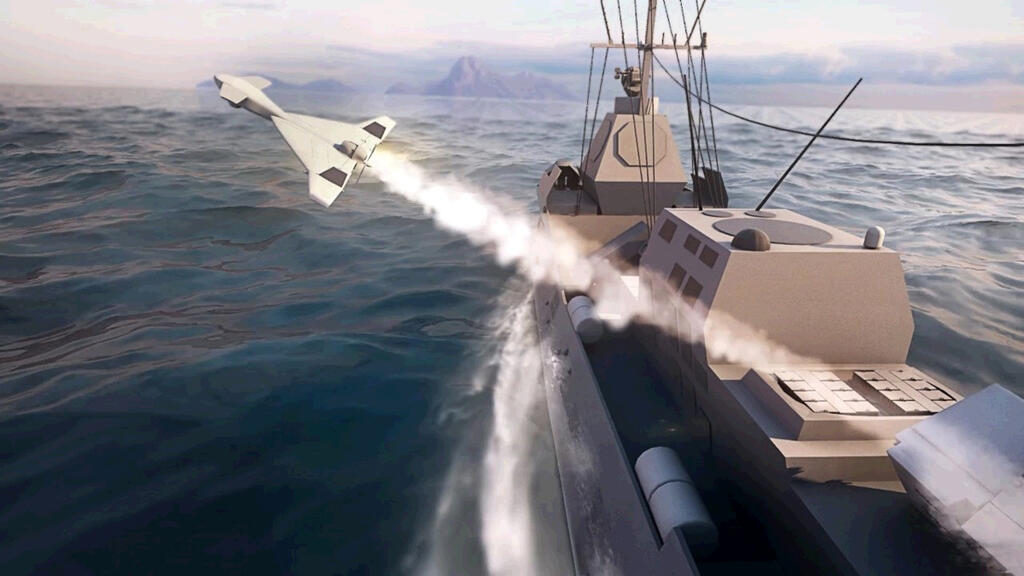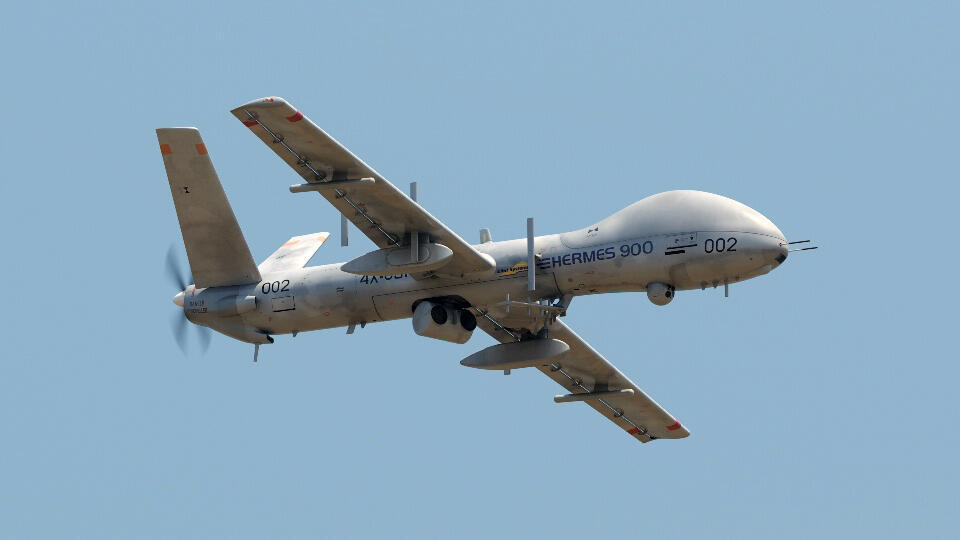
Kashmir’s drone war reveals the reach of Israel’s military-industrial complex
Loitering munitions built in Israel now define warfare thousands of kilometers away.
The renewed fighting between India and Pakistan has diverted global attention from the ongoing wars in the Middle East, now stretching into their second year. The escalation has raised fears of a broader conflict between the nuclear-armed rivals. On Sunday, the U.S. reported that it had brokered a ceasefire agreement between the two sides.
The weekend saw continued exchanges between Indian and Pakistani forces, with a notable presence of Israeli-made weapons systems. Over the past two decades, Israel’s defense industries have supplied India with a wide array of technologies, including the Harop loitering munition—one of the most prominent.
The Harop is a so-called "suicide drone" developed and manufactured by Israel Aerospace Industries (IAI), specifically at its MBT Missile Division Plant B in central Israel. It has a range of several hundred kilometers and carries an explosive payload of about 10 kilograms. Capable of loitering for up to six hours at altitudes of several kilometers, the Harop is guided remotely to dive into and destroy its target upon command. Other loitering munitions derived from the Harop include the Harpy and the Harpy NG, each costing several hundred thousand dollars.
India began acquiring Harop drones around 15 years ago and has significantly expanded its fleet in recent years through deals estimated at several hundred million dollars. During the latest flare-up in the Kashmir region, the Indian Army reportedly deployed dozens of these drones. Pakistani sources claimed their military intercepted between 12 and 25 drones during the skirmishes, sharing footage of downed UAV remnants on social media. It remains unclear whether all interceptions occurred before impact or if some wreckage came from drones that had already completed their missions.
One video showed debris bearing markings from Enercon Technologies, an Israeli manufacturer of power supplies for defense systems. Based in the Barkan industrial zone near Ariel, Enercon was acquired in late 2024 by U.S.-based Bel Fuse for $320 million. It had previously been owned by the Fortissimo fund.
Pakistan also claimed it had shot down a Heron drone, another IAI product previously sold to the Indian Air Force. India, meanwhile, reported intercepting several dozen drones launched by Pakistan.
Kashmir is not the first combat zone where Israeli loitering munitions have been deployed. Azerbaijan used Harop drones extensively against Armenian forces during the conflict in Nagorno-Karabakh.
In addition to IAI, Elbit Systems has also become a key supplier to India, offering systems such as the SkyStriker. This loitering munition has a shorter flight time (about two hours) and range compared to the Harop, and carries a smaller warhead (approximately 5 kilograms). Designed for covert missions, the SkyStriker is fast and has a low acoustic signature. India’s ground forces also use thousands of Rafael-made Spike anti-tank missiles, now deployed in dozens of militaries worldwide.
India’s military buildup, particularly against Pakistan and China, led to a $100 million deal for the SkyStriker around four years ago. The agreement included technology transfer and mandated local production in India.
Elbit further manufactures its Hermes 450 and Hermes 900 drones in India for domestic use. Other Israeli technologies adopted by India include the Barak 8 air defense system, jointly developed with IAI. The Barak 8 has been integrated into Indian Navy warships and also used by air and ground forces. These defense projects reflect industrial collaboration between India’s Ministry of Defense and IAI, totaling an estimated $3 billion.
Chinese J-10 Fighter Based on Israeli Lavi?
The conflict has also spotlighted Pakistan’s Chinese-made J-10 fighter jets, built by Chengdu Aircraft Corporation. Pakistan purchased at least one squadron in response to India’s acquisition of Dassault Rafale aircraft from France.
Aviation experts have long noted the resemblance between the J-10 and Israel’s cancelled Lavi fighter jet, whose development at IAI ended in 1987 under U.S. pressure and economic constraints. Some analysts speculate that Israeli technologies—communications systems, avionics, radar, and composite materials—made their way to China after the Lavi program was shuttered, though no official confirmation has ever been given by Israeli authorities.
According to Pakistani reports, one of its J-10s shot down two Indian aircraft in a recent dogfight. Western analysts, particularly in the U.S., are monitoring the performance of these Chinese systems—including air defense platforms and long-range air-to-air missiles—to glean insights that could be relevant in future global conflicts.
About two weeks ago, India’s Ministry of Defense confirmed a new order for dozens of additional Rafale jets in a deal valued at nearly $7.5 billion, to be completed by the end of the decade. The current escalation in Kashmir may also influence New Delhi’s next procurement decision: whether to buy Russia’s SU-57 or the American F-35 fighter jet.
U.S. President Donald Trump has encouraged Indian Prime Minister Narendra Modi to opt for the F-35—already in service with the Israeli Air Force—as part of a broader effort to deepen strategic ties. While India appears to be weighing both options, insiders believe the hesitation may be a negotiating tactic aimed at securing a better price from Washington.
What may ultimately tilt the balance toward the American jet is the F-35’s proven combat performance—especially by Israel during its current war. This assessment is reinforced by India’s ongoing shift away from Russian arms due to the Ukraine conflict. Russia’s war effort has strained its arms production, limiting its ability to fulfill foreign orders. Meanwhile, India has begun positioning itself as a global arms exporter, targeting markets once dominated by Russia, including parts of Africa, South America, and the Arab world.
Israel’s Role in India’s Defense Strategy
Israeli defense firms continue to play a significant role in India. Their technologies are highly regarded by India’s defense ministry and military, but these firms must continuously demonstrate relevance in a highly competitive market. A key element of their continued success lies in the transfer of technology that enables India to develop its own domestic weapons manufacturing base.
India requires foreign defense contractors to enter joint ventures with Indian firms, giving the local companies majority control. Israeli firms recognize that these "Indian weddings" may undermine their profit margins and complicate marketing strategies. Nevertheless, the consensus is that remaining engaged in the Indian market is critical.
Record-Breaking Defense Exports
India remains the world’s largest arms importer, although it briefly dropped to second place in 2023 behind Ukraine, according to the Stockholm International Peace Research Institute. At the same time, Indian firms are now competing globally in arms tenders, offering increasingly competitive pricing through partnerships with Western companies—including Israeli firms.
This development poses both opportunities and risks for Israel. On one hand, partnerships may allow Israeli-designed systems to reach broader markets; on the other, lower production costs in India could undercut Israeli exports. To mitigate these risks, Israel’s Defense Export Control Agency must maintain vigilant oversight to protect trade secrets and safeguard proprietary technologies.
Still, Israeli defense executives are pragmatic. “It’s better to be inside the deal than left out entirely,” one senior industry source told Calcalist. “It just reinforces the need for us to maintain technological superiority and bring unique value to the market.”
In 2023, Israeli defense exports reached a record $13 billion, with roughly half destined for Asian countries, including India. The country’s major exporters—Elbit Systems, IAI, and Rafael—led the way.
The Defense Export Agency is expected to release its 2024 figures in the coming weeks, and early indicators suggest another record year. This would be particularly significant in light of mounting international pressure over Israel’s operations in Gaza, which have prompted sanctions and attempts to block participation in global defense exhibitions.
Nonetheless, the ubiquity of Israeli weapons in conflict zones—and their growing sales—highlight the contradictions of a world that criticizes Israeli military actions while relying on its defense technologies.
















